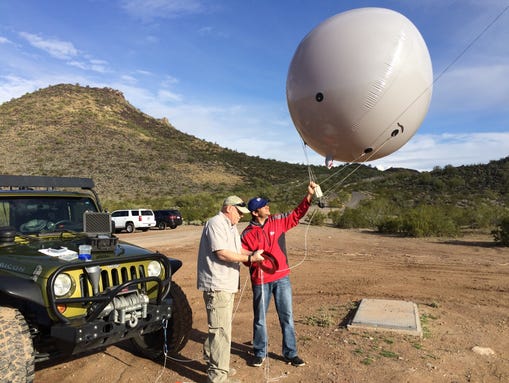“Drones are here to stay, and they are a very valuable tool,” said Randy Anglin of Lionstrike Forensics. “But kites and balloons have become a very valuable tool for what we do.”
They’ve also become necessary.
Since the FAA placed a ban on all commercial use of drones, Anglin, a retired DPS officer who now specializes in surveillance security, crime-scene analysis and accident reconstruction, began researching other ways to capture video and images from above.
By using kites and balloons, Anglin has found a loophole as big as the Arizona sky.
There are only two regulations on tethered aircraft: They cannot be operated above 500 feet within five miles of an airport, and they can’t weigh more than five pounds.
“It’s tethered. That’s the big difference. And some day they may end up putting some sort of regulation on tethered equipment,” Anglin said.
Though drones are ideal for steady shots of video in short spurts, Anglin has discovered that kites and balloons have their own advantages. They can stay in the air for days at a time and they are much cheaper.
Winds at a speed of 5 to 30 mph are needed to keep the kite afloat and stable. The balloon relies on about $75 worth of helium and should fly in little to no wind to be useful.
“More wind allows for the kite to go straight up and be more useful. With less wind, the balloon goes straight up,” Anglin said recently, while standing next to his jeep in a desert park north of the 101 freeway in the West Valley. A five-foot kite with a Go-Pro camera attached to its string flew about a hundred feet in the air.
A large balloon, about five feet in diameter, was tethered to his jeep as well, blowing in the breeze a couple dozen feet above the ground.
Anglin’s clients include police agencies, corporations and civil attorneys. He captures photos and video that are used most often for real estate development, government site surveys and accident reconstruction. He has also provided surveillance video of properties that are targeted by thieves for satellite dishes, copper and steel.
Usually those kinds of jobs require a camera fixed to the ground or a mast attached to the ground.
“I once spent four months on a grocery store rooftop watching over a site until we got what we wanted,” Anglin said.
Although he says his work has been used in criminal investigations, he is not at liberty to share those images.
Anglin has found ways to stabilize camera footage on kites by attaching a small camera to the string of the kite. The camera is cradled in a turbulence-reducing harness. Then a second person provides a second anchor to a fixed point on the kite string.
Anglin has practiced for many months leveraging the various factors involved with kites and balloons in order to manipulate the elevation and location of the camera.
 Anglin shows reporter Joe Dana how his balloon surveillance system works. (Photo: 12 News)
Anglin shows reporter Joe Dana how his balloon surveillance system works. (Photo: 12 News)
Anglin’s business model makes what’s old new again. The idea of using kites and balloons for surveillance became useful during World War I, when French and German forces developed man-carrying kites that allowed soldiers to take photos of enemy territory from hundreds of feet in the air.
Drones will eventually play a larger role in Anglin’s businesses.
“Drones are powerful. You don’t want to fly one over crowds of people. You would never want to take a quadricopter over a little league game,” Anglin said.
Meanwhile, Anglin is taking advantage of his growing tool box to do his job. He’s in the process of building a 19-foot kite that will be able to hold heavier equipment and potentially stay in the sky longer.
Along the way, he’s taken up kite-flying as a hobby. Recently, he floated a kite above an early 20th-century cemetery in a remote desert area near Congress, Ariz.
“I did that just for fun,” Anglin said.
Source: AZ Central
